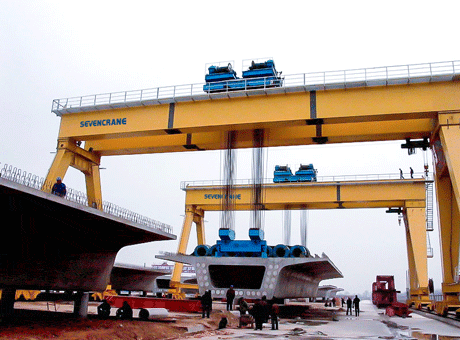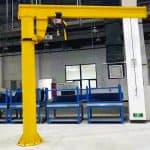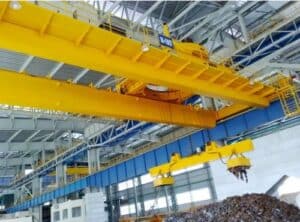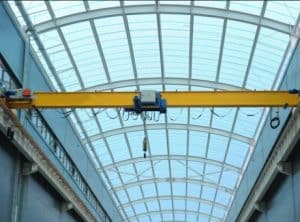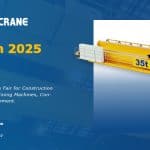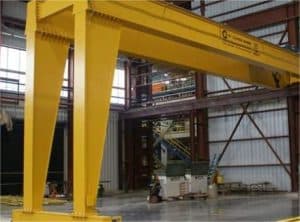Safety Management of Hoisting Machinery Use
1. Annual inspection
Conduct a comprehensive inspection of all lifting machinery in use at least once a year. Cranes that have been out of service for more than 1 year, encountered earthquakes of magnitude 4 or above or major equipment accidents, or cranes operating in the open that have withstood winds of magnitude 9 or above, should undergo a comprehensive inspection before use.

2. Monthly inspection
Inspection items include: whether safety devices, brakes, clutches are abnormal, reliable and accurate. The status of important parts (such as spreaders, wire rope pulleys, brakes, slings and auxiliary equipment, etc.), whether they are damaged, and whether they should be scrapped leakage and working performance of electrical, hydraulic systems and their components; power systems and controllers, etc. If the lifting mechanism has been out of service for more than one month, the above inspection should also be done before use.
3. Daily inspection
Before daily operation, the safety conditions of various safety devices, brakes, operating control devices, emergency alarm devices, tracks, and wire ropes should be checked. If abnormal conditions are found during inspection, they must be dealt with promptly, and operation while sick is strictly prohibited.
1. Safe operation techniques for crane drivers
1. Before starting the operation, it should be confirmed that it is in a safe state before starting: whether all controllers are placed in the zero position; whether the minimum distance between the crane and other equipment or fixed buildings is more than 0.5m; whether the mobile crane site is leveled as required.
2. Before driving, the bell or warning must be sounded; when approaching people during operation, the bell or warning should be given intermittently.
3. During normal operation, the driver shall not use the limit position limiter to stop; shall not reverse the vehicle for braking; shall not carry out inspection and maintenance during the lifting operation; shall not adjust the brakes of the lifting and luffing mechanisms with load. Or carry a load to increase the working range; hoisted objects are not allowed to pass over people’s heads, and no one is allowed to stand under the hoisted objects and the lifting arm.
4. Strictly operate in accordance with command signals. Emergency stop signals must be executed immediately no matter who sends them.
5. When the hoisting load is close to or reaches the rated value, or when hoisting dangerous objects (liquid metal, harmful substances, flammable and explosive substances), carefully check the brakes before lifting, and try lifting with a small height and short stroke to confirm that there are no problems before proceeding. Lifting.
6. The minimum distance between various parts of the crane, hoisting load and auxiliary equipment and transmission lines should meet safety requirements.
7. The driver should not operate under the following circumstances: the crane structure or parts (such as hooks, wire ropes, brakes, safety protection devices, etc.) have defects and damage that affect safe work; the hoisted objects are overloaded or may be overloaded, and the hoisted objects are The quality is unclear; the hanging object is buried or frozen in the ground, or is squeezed by other objects; the hanging object is not tied firmly, or the hanging object is not tied firmly, or the hanging is unstable, and there is no gap between the edges of the lifted object and the sling. Add padding; there are people or floating objects on the hoisted objects; the work site is dark and the site, hoisted objects or command signals cannot be clearly seen. Do not pull or lift at an angle during operation.
8. When there is a sudden power outage during work, all controllers should be reset to zero and the main power supply should be turned off. Before resuming work, you should first check whether the crane is working normally and confirm that it is safe before operating normally.
9. If there are two sets of main and auxiliary lifting mechanisms, it is not allowed to use the main and auxiliary hooks at the same time (except for special lifting allowed by the design).
10. When two or more cranes lift the same heavy object, each crane must not be overloaded. During the lifting process, the wire rope should be kept vertical and the operation should be synchronized. During the lifting, the relevant responsible personnel and safety technicians should be on hand to provide guidance.
11. For rail cranes operating in the open air, when the wind force is greater than level 6, the operation should be stopped; when the work is completed, the crane should be anchored.

2. Safety operation techniques of rope workers
1. Prepare the spreader
The weight and center of gravity of the hoisted object must be estimated accurately. If it is a visual estimate, the spreader should be selected by increasing 20%. A careful safety inspection of the spreader must be carried out for each hoisting. If it is an old sling, it should be downgraded according to the situation. , never overload or use a scrapped spreader.
2. Bundle hanging objects
Carry out necessary classification, cleaning and inspection of hanging objects. Hanging objects cannot be squeezed by other objects, and buried or frozen objects must be completely dug out. Cut off all connections with surrounding pipes and lines to prevent overloading; remove debris on the surface or in the cavity of the hanging object, lock or tie the movable parts tightly, and items of different shapes or sizes must not be hung together without special binding to prevent falling and injuring people; the burrs on the strapping parts of the hanging objects should be smoothed, and the sharp corners should be padded to prevent damage to the slings after heavy lifting.
Measures should be taken for hanging objects with smooth surfaces to prevent the slings from sliding or hanging after lifting. The object slips; when lifting large and heavy objects, an induction rope should be added. The length of the induction rope should be such that the rope operator can hold the rope head while avoiding the directly below the suspended object so that the rope operator can use it in the event of an accident. This rope controls the hanging object.
3. Hook lifting
ElThe 1 ton wall mounted jib crane consists of a bracket, jib installation, swivel installation and electric hoist (electric chain hoist). The bracket is fixed on the wall or steel structure column and can be rotated according to user needs. The rotating part is divided into manual rotation and electric rotation. Electric hoists (electric chain hoists) are installed on cantilever rails and are used to lift heavy objects. Cantilever cranes are widely used in light and small lifting applications in mines, workshops, assembly lines, warehouses, and docks. The utility model has the advantages of novel structure, reasonableness, simplicity, convenient operation, sensitive rotation, light weight, and sensitive load movement. The operation of this machine is realized through the handle control button, which controls the lifting and horizontal walking of the sevencrane 1 ton wall mounted jib crane. hook should be located directly above the center of gravity of the object being hoisted. Do not hang the hook diagonally to prevent the object from flipping and swinging after lifting. If the object is tall and needs padding to climb the hook or remove the hook, the footrest must be firmly padded. In fact, it is prohibited to use easy-rolling objects (such as logs, pipes, rollers, etc.) as footrests. Safety belts must be worn when climbing to prevent injuries from falling.

Hooking adheres to the “five no-hanging” principle
(1) Do not hang lifting or hoisting objects whose mass is unknown, do not hang when the center of gravity is unclear, and do not hang sharp-edged or slippery workpieces without cushioning.
(2) The spreaders and supporting tools are unqualified or scrapped and not hung, and the packaging is loose and poorly bundled and not hung, etc.
(3) When multiple people are hoisting the same hoisted object, a dedicated person should be responsible for the command. Only after confirming that the hoisting is complete and all personnel have left and stood in a safe position can the hook signal be initiated.
(4) When lifting the hook, ground personnel should not stand in a place where the hanging object may tip over or fall.
(5) If the working site is on a slope, you should stand above the slope (not in a dead corner) to prevent the hanging object from rolling along the slope and injuring people after it falls.
4. Unhook and uninstall
Before the hanging objects are transported in place, the placement location should be selected. When unloading, do not squeeze electrical lines and other pipelines, and do not block the passages. Different measures should be taken for different types of hanging objects to support, stabilize, and place them in categories. No mixing or mixing is allowed. Squeeze each other and place them in the air to prevent hanging objects from rolling down, falling sideways, or collapsing; when unhooking, you should wait until all slings are completely relaxed before unhooking, and confirm that all ropes are removed from the hooks before lifting the hook. Do not shake the rope to remove the hook. , and it is not allowed to use cranes to pull ropes.
5. Command of the transportation process
During the entire process of the operation (especially when heavy objects are suspended in the air), neither the commander nor the riggers are allowed to leave their posts without authorization. They should pay close attention to the hanging objects and the surrounding conditions, identify problems, and send out command signals in a timely manner.










